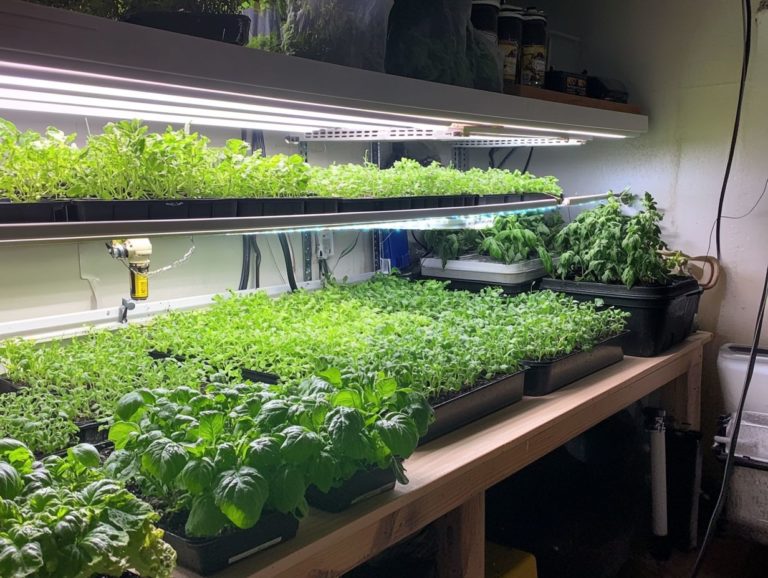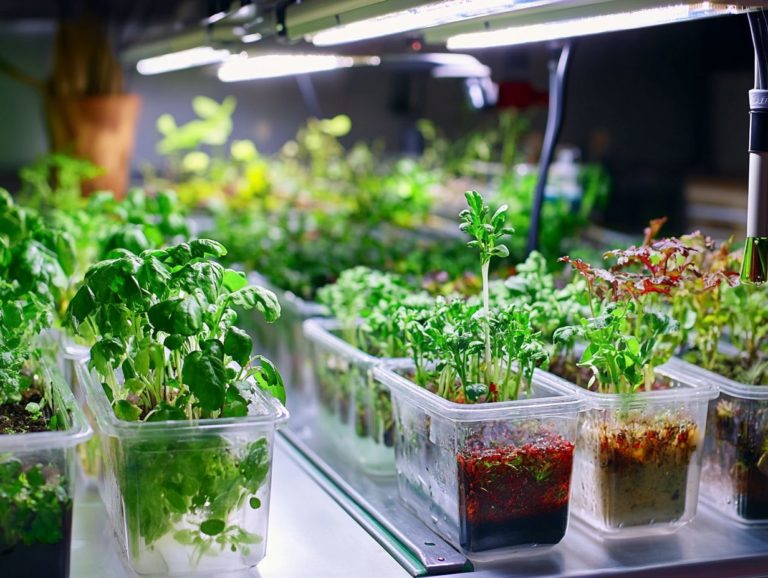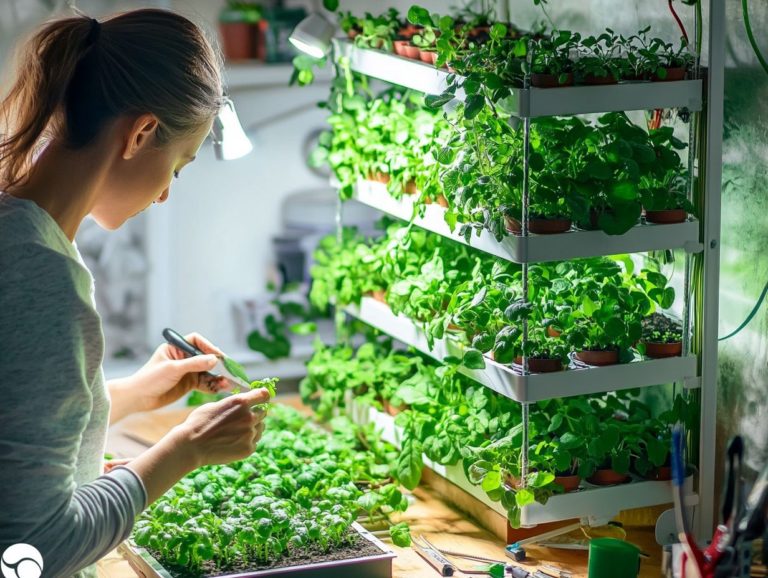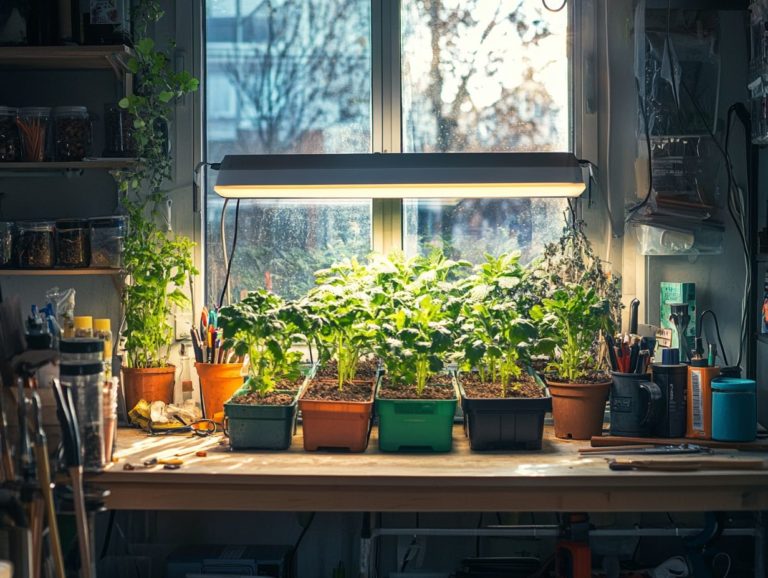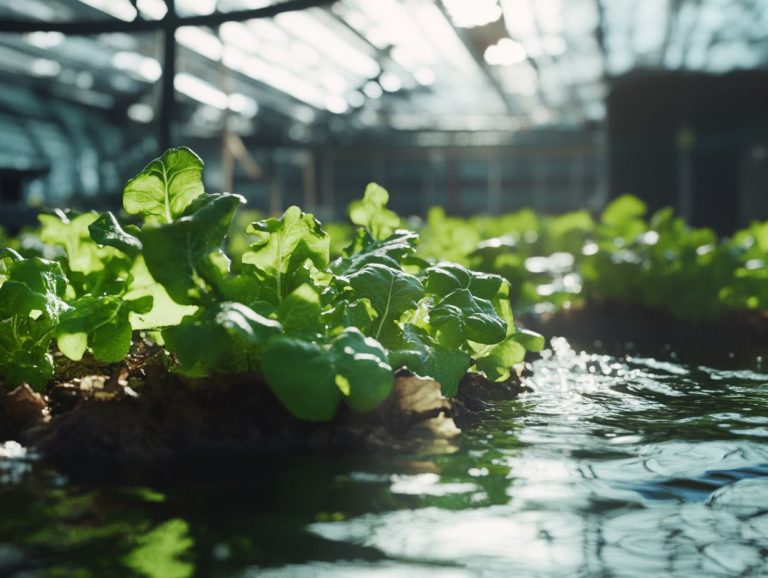10 DIY Hydroponic Kits You Can Try Today
Hydroponics is revolutionizing the way you approach gardening. Imagine growing your own fresh produce right at home! It presents a soil-less method that s perfectly suited for urban environments or anyone eager to cultivate fresh produce.
This article delves into DIY hydroponic kits tailored for both beginners and seasoned gardeners. You ll gain insights into the benefits and essential components of these systems, alongside a comprehensive step-by-step setup guide. Everything you need to kick off your hydroponic journey is right here.
You will also discover ten outstanding kits designed to help you grow cuttings and more!
Contents
- Key Takeaways:
- 2. Benefits of Using a DIY Hydroponic Kit
- 3. Types of DIY Hydroponic Kits
- 4. Basic Components of a DIY Hydroponic Kit
- 5. Factors to Consider When Choosing a DIY Hydroponic Kit
- 6. Step-by-Step Guide to Setting Up a DIY Hydroponic Kit
- 7. Maintenance and Care of a DIY Hydroponic System
- 8. 10 DIY Hydroponic Kits to Try Today
- 9. Tips for Successful Hydroponic Gardening
- 11. What Are the Key Features of Each Kit?
- 12. What Are the Pros and Cons of Each Kit?
- 13. How Do These Kits Compare to Professional Hydroponic Systems?
- Frequently Asked Questions
Key Takeaways:
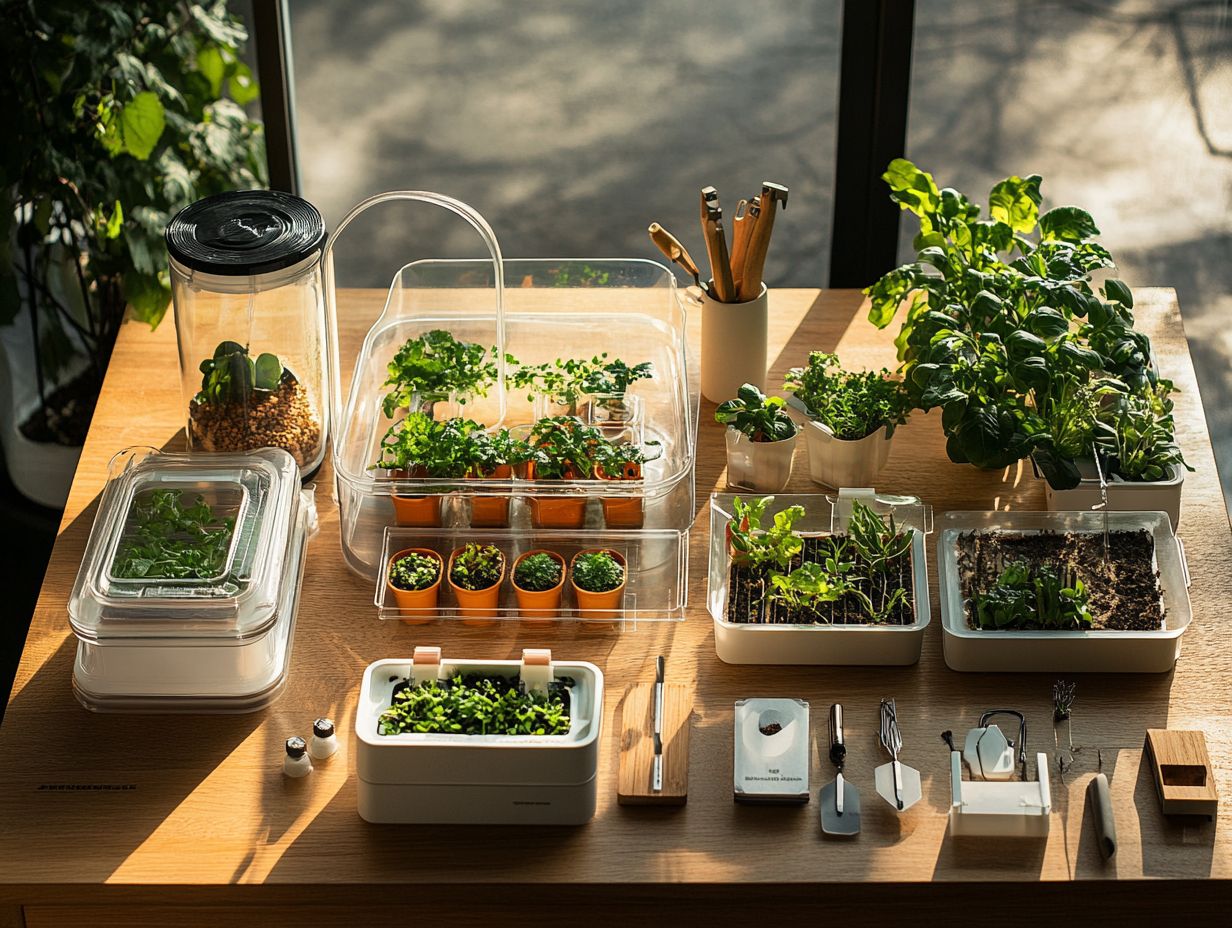
- Experience the benefits of using a DIY hydroponic kit, including cost savings and year-round gardening opportunities.
- Consider factors such as space, budget, and plant type when choosing a DIY hydroponic kit.
- Follow a step-by-step guide and proper maintenance for successful and sustainable hydroponic gardening.
2. Benefits of Using a DIY Hydroponic Kit
Utilizing a DIY hydroponic kit offers you a wealth of benefits that cater to both novice and experienced growers. These kits promote healthy living and embrace urban farming practices. They provide a hands-on approach to home growing, enabling you to cultivate your own crops, such as lettuce and kale, in a controlled environment.
This ensures peak freshness and maximum nutrient content. One of the standout advantages for you is the cost-effectiveness; by growing your own food at home, you can save significantly on grocery bills, particularly for organic produce that often comes with a premium price tag.
These systems grant you complete control over growth conditions. You can fine-tune light, acidity levels, and nutrient mixes to optimize plant health. This level of customization leads to higher yields while accelerating growth cycles compared to traditional soil-based methods.
Accessibility is another key feature. Many kits fit perfectly into small spaces, making them ideal for urban dwellers. Crops such as strawberries and herbs thrive in these setups, promoting a healthier lifestyle and encouraging you to indulge in fresh, home-grown food.
3. Types of DIY Hydroponic Kits
When diving into the world of DIY hydroponic kits, it s crucial to grasp the variety of options available, each designed to meet different growing needs and preferences. Whether you’re drawn to Deep Water Culture systems that deliver nutrient-rich water for robust crop growth or simpler starter kits, the choices abound.
Among these options, the Nutrient Film Technique (NFT) stands out. It offers a continuous flow of nutrient solution over the roots, making it particularly well-suited for leafy greens like lettuce and herbs. This optimizes oxygenation for healthier plants.
If you re looking for a more compact setup, the Ebb and Flow system cycles nutrients efficiently and is fantastic for larger plants such as tomatoes or peppers. Each system comes with its own unique advantages, tailored to accommodate varying levels of gardening expertise.
This presents you with an exceptional opportunity to cultivate fresh produce all year round, elevating your home gardening experience to new heights.
4. Basic Components of a DIY Hydroponic Kit
A DIY hydroponic kit consists of essential components that create the ideal growing environment for your plants. Each part is crucial for the health and productivity of your garden.
The storage container serves dual purposes: it holds water while acting as a reservoir for nutrient absorption. Meanwhile, the air pump infuses oxygen an essential ingredient for root respiration and overall plant vitality.
A pH meter is critical for maintaining balanced acidity levels, as plants flourish within a specific pH range. Hydroponic nutrients supply the minerals necessary for vigorous growth.
For optimal results, it’s vital to regularly check and calibrate these components, ensuring they work in perfect harmony to support thriving, healthy plants.
5. Factors to Consider When Choosing a DIY Hydroponic Kit
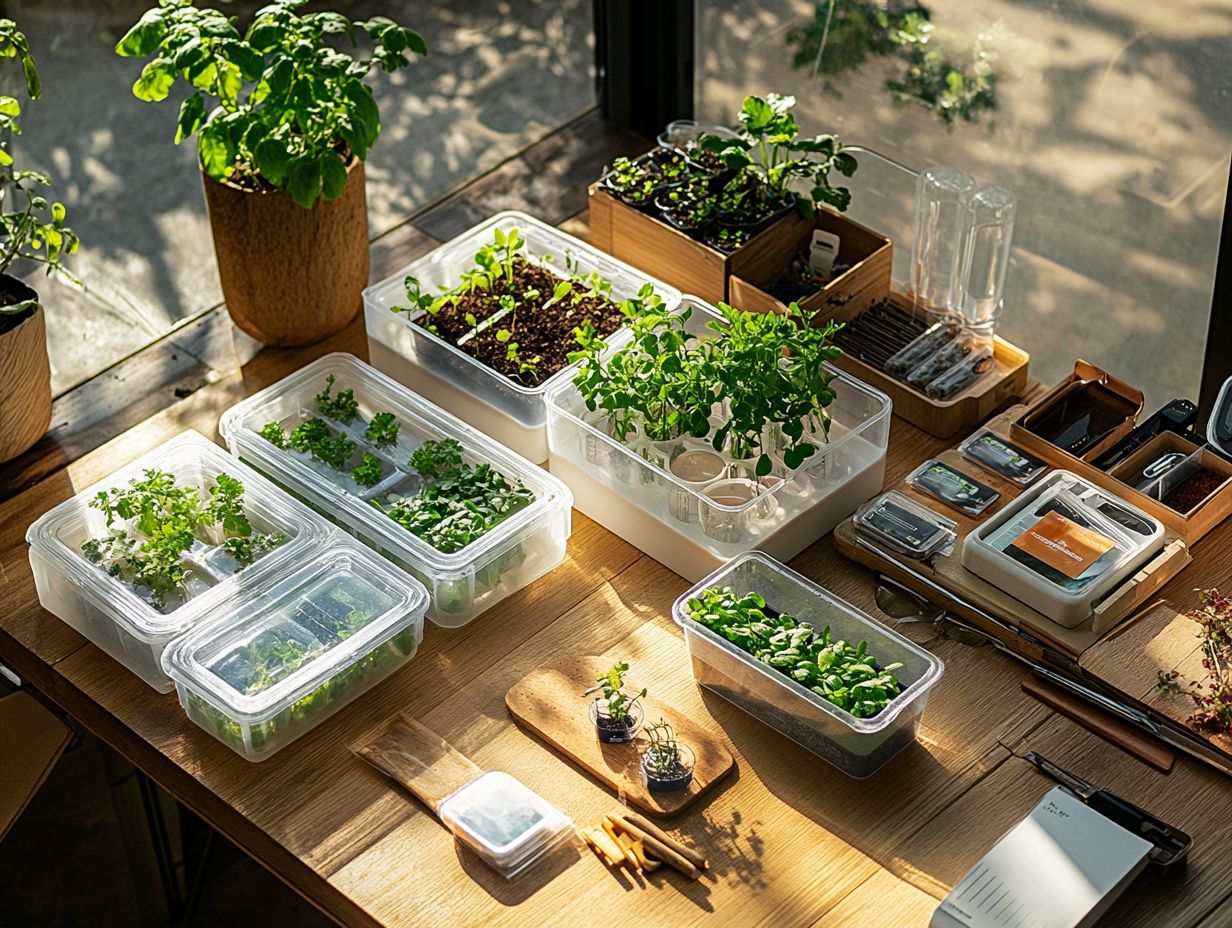
Choosing the right DIY hydroponic kit is essential for success in urban farming. Consider the size and type of kit based on your available space and the crops you want to grow.
Your space matters a cozy balcony or a spacious backyard will dictate what kit suits you best. Keep your budget in mind to avoid compromising quality while narrowing your options.
Different plants have unique needs. Leafy greens thrive in simple setups, while fruit-bearing plants need more advanced systems.
Assess your comfort with technology and maintenance. Pick a hydroponic method that fits your urban farming goals.
6. Step-by-Step Guide to Setting Up a DIY Hydroponic Kit
Setting up your DIY hydroponic kit is an exciting journey with straightforward steps. Each step is vital for the successful growth of your crops.
- Select an appropriate container like a plastic tote or bucket. Make sure it holds enough water for your plants. After choosing, drill holes in the lid to fit net pots.
- Mix your hydroponic nutrient solution as per package instructions. Monitor the pH levels, aiming for a range of 5.5 to 6.5 for the best nutrient absorption.
- As your system starts, don’t forget maintenance. Regularly check water levels and look for algae or debris. Keeping the reservoir clean prevents clogs and maintains a healthy environment for your plants.
7. Maintenance and Care of a DIY Hydroponic System
Maintaining your DIY hydroponic system is crucial for healthy, productive plants. Consistent care and attention are key.
Prioritize these maintenance tasks:
- Monitor water levels.
- Ensure a clean reservoir.
- Replenish hydroponic nutrients.
These tasks create optimal growing conditions. Regularly check pH levels, as they influence nutrient absorption. Watch for algae growth to prevent system blockages.
Examine your plants and their roots to catch potential issues early. Establishing a routine for these checks streamlines the process and helps you troubleshoot effectively.
8. 10 DIY Hydroponic Kits to Try Today
Ready to dive into hydroponic gardening? Explore these 10 DIY hydroponic kits that suit various needs and preferences.
With the growing trend in sustainable living, selecting the right hydroponic kit is vital. Whether you’re a beginner or a seasoned gardener, these kits come with everything you need to cultivate thriving plants at home.
Each system has unique features tailored to specific crops. Enjoy a successful harvest while customizing your garden to meet your culinary cravings. Explore this selection and find the hydroponic kit that matches your gardening goals!
9. Tips for Successful Hydroponic Gardening
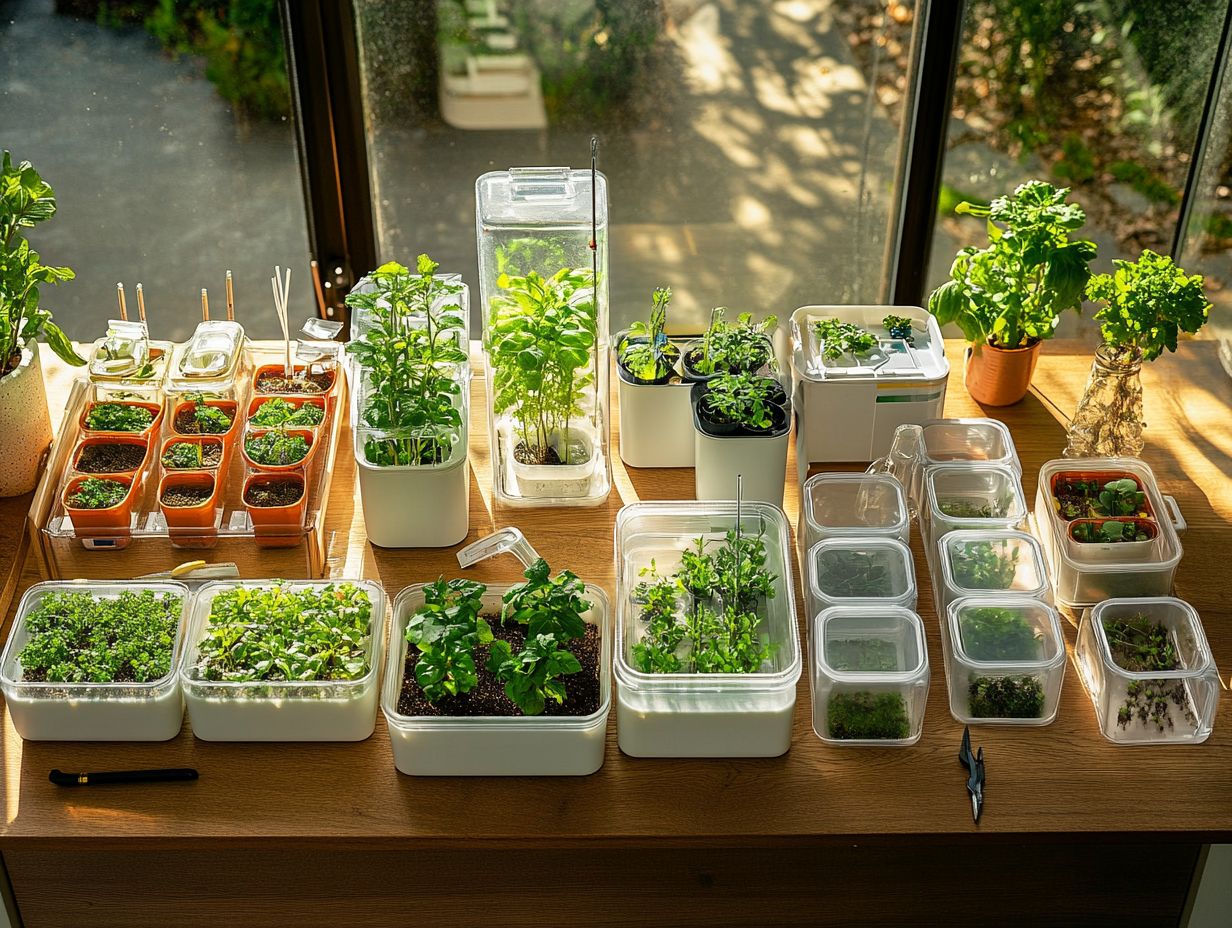
Successful hydroponic gardening requires specific knowledge and practices. These can significantly boost your yield and overall experience.
Understand which crops thrive in hydroponic systems. Maintain optimal nutrient levels and incorporate healthy living principles to unlock your urban farming potential.
Pay attention to environmental controls like light intensity, temperature, and humidity. These factors are crucial for plant health.
Select high-yield varieties designed for hydroponic growth. This choice will make your gardening process more efficient.
Manage water carefully to ensure your plants receive the right moisture. This minimizes the risk of rot and other issues.
By monitoring and adjusting these factors, you can turn any space into a thriving oasis. Start your rewarding gardening journey today!
11. What Are the Key Features of Each Kit?
Each DIY hydroponic kit offers unique features to elevate your home growing experience. Understanding these attributes helps you select the perfect kit for your gardening goals.
Some kits are compact and made from durable, lightweight materials, making them ideal for small apartments or balconies. Others include advanced components like automated timers and nutrient dispensers.
Many kits also come with essential tools, such as pH testing kits (tools for measuring water acidity) and measuring scoops. These help you effectively monitor and maintain your hydroponic system.
Choose a kit that fits your specific needs and space constraints. This way, you can enjoy gardening without the mess of traditional soil methods.
12. What Are the Pros and Cons of Each Kit?
Evaluating the pros and cons of each DIY hydroponic kit is essential for informed decision-making. Understanding the benefits and drawbacks allows you to choose the best option for your needs.
In home gardening, knowing the distinct features of various hydroponic systems enhances your experience. Consider factors like ease of setup and maintenance they greatly influence your choice.
Some kits are user-friendly, perfect for beginners. Others cater to experienced growers who want advanced functions.
Cost-effectiveness varies widely. Some kits offer long-term savings on water and nutrients, while others may require a higher upfront investment.
Crop suitability is another important factor. Some kits are designed for specific plants, affecting yield and growth speed. Weigh these factors carefully to find a kit that matches your gardening aspirations.
13. How Do These Kits Compare to Professional Hydroponic Systems?
Comparing DIY hydroponic kits to professional hydroponic systems reveals striking differences in complexity, cost, and scalability. Each caters to distinct needs within home growing and urban farming. While DIY kits are crafted for ease of use and accessibility, professional systems offer advanced functionalities that are often more suitable for commercial applications.
Recognizing these distinctions enables you to determine which system aligns best with your goals. For hobbyists, DIY kits provide a delightful and hands-on gardening experience without the difficult to learn curve or high costs that often accompany professional setups. These kits are easy to manage, making them perfect for casual gardening enthusiasts!
If you’re an urban farmer aiming to maximize output, investing in a professional hydroponic system might be your best bet. Such systems are engineered for high productivity, scalability, and reduced operational challenges. This ultimately leads to greater crop yields and efficiency over time.
Frequently Asked Questions
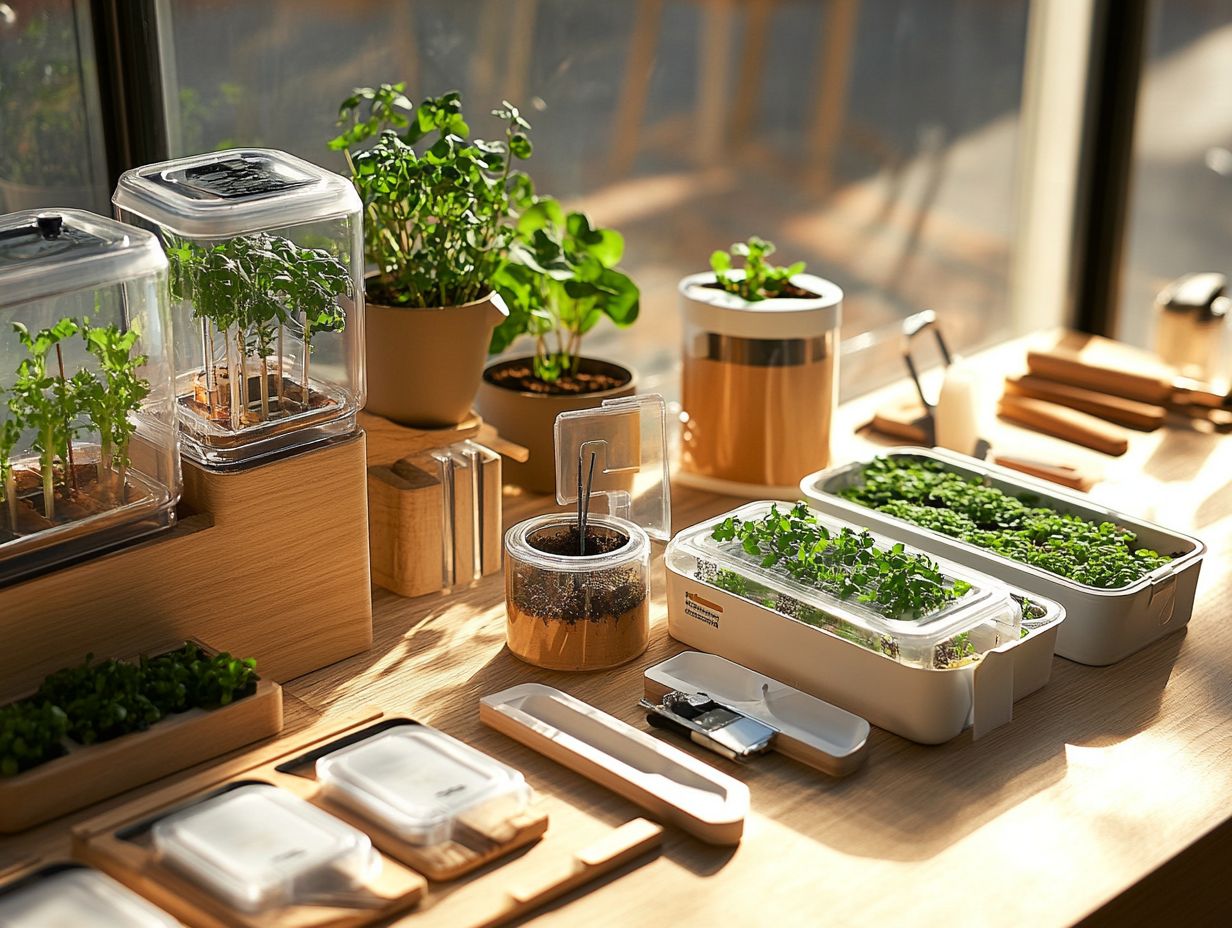
What are hydroponic kits?
Hydroponic kits are self-contained systems that allow you to grow plants without soil. They typically include all the necessary components, such as a container, growing medium, nutrients, and a water supply, making it easy for beginners to start growing their own plants.
Why should I try a DIY hydroponic kit?
DIY hydroponic kits are a great way to learn about hydroponic gardening and have complete control over the growing process. They are also a cost-effective way to start your own indoor garden and can be customized to fit your specific needs.
What types of plants can I grow with a hydroponic kit?
You can grow a wide variety of plants with a hydroponic kit, including herbs, vegetables, and even small fruits. Some popular options include lettuce, tomatoes, basil, and strawberries.
Do I need any special skills or equipment to use a DIY hydroponic kit?
No, most DIY hydroponic kits are designed for beginners and require minimal skills or equipment. As long as you can follow instructions and have access to basic household tools, you should be able to successfully use a hydroponic kit.
How much space do I need for a hydroponic kit?
One of the great things about hydroponic kits is that they can be used in small spaces. Depending on the size of the kit, you can set it up on a windowsill, countertop, or even a small corner of a room. Some kits are also stackable, allowing you to maximize vertical space.
Are hydroponic kits suitable for all climates?
Yes, hydroponic kits are suitable for all climates since they can be used indoors. This allows you to control the temperature, humidity, and light levels, creating an optimal growing environment for your plants regardless of the weather outside.
In summary, whether you’re a hobbyist or an urban farmer, hydroponic kits offer versatile solutions for growing plants without soil. Explore DIY kits today and take your gardening to the next level!

